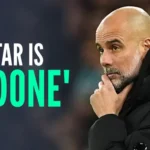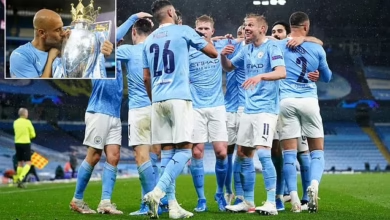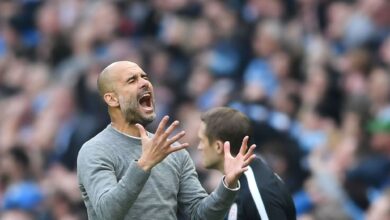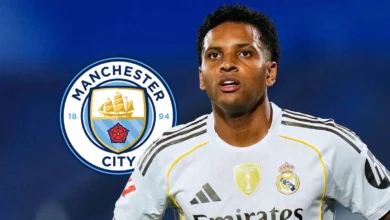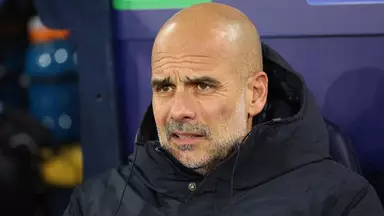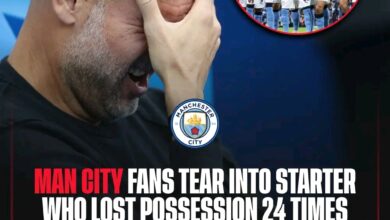Manchester City’s Right-Back Pursuit: The Achraf Hakimi Connection

Manchester City find themselves in an unusual position as they navigate the summer transfer window of 2025. The departure of Kyle Walker to Burnley has left a significant void in their defensive setup, creating an urgent need for reinforcement in the right-back position. This development has thrust the club into the transfer market at a time when quality defenders are increasingly difficult to acquire, and the premium for established talent continues to soar.
The situation at the Etihad Stadium is more complex than simply replacing a departing player. Pep Guardiola’s tactical system demands specific qualities from his full-backs, requiring them to be versatile enough to contribute in multiple phases of play. The right-back position, in particular, has become increasingly specialized under Guardiola’s guidance, with players expected to provide width in attack, defensive solidity, and the intelligence to tuck into midfield when the tactical situation demands it.
Rico Lewis, widely regarded as one of the most promising young talents in English football, represents the closest thing to a natural right-back currently available in Manchester City’s squad. However, the young defender’s own ambitions lie elsewhere on the pitch. Lewis has consistently expressed his preference for playing in midfield, viewing himself as a central player rather than a traditional full-back. This self-perception creates a fundamental mismatch between the player’s aspirations and the club’s immediate tactical needs.
The situation has been further complicated by the emergence of Matheus Nunes as Guardiola’s preferred option for the right-back role. Nunes, who was originally signed as a midfielder, underwent a tactical transformation last season that saw him converted into a defensive position. His adaptation to the role has been impressive enough to earn him favor over Lewis, demonstrating the Portuguese player’s versatility and tactical intelligence. However, relying on a converted midfielder to fill such a crucial defensive position long-term represents a significant risk for a club with Manchester City’s ambitions.
Manchester City’s primary target for the right-back position has been Tino Livramento, the Newcastle United defender who has captured the imagination of scouts and coaches alike with his performances in the Premier League. Livramento represents the ideal profile for a modern full-back, combining pace, technical ability, and the tactical awareness necessary to excel in Guardiola’s system. His youth and potential for further development make him an attractive long-term investment for the club.
However, Newcastle United’s reluctance to part with their prized asset has created a significant obstacle in City’s pursuit. The Magpies have made it clear that they view Livramento as a cornerstone of their own project, and any potential departure would require a substantial financial incentive. The rumored asking price of £80 million represents a staggering valuation for a right-back, reflecting both Newcastle’s determination to retain their player and the inflated nature of the current transfer market.
This astronomical fee would make Livramento one of the most expensive defenders in football history, a price point that even Manchester City, with their considerable financial resources, must carefully consider. The club’s recent adherence to Financial Fair Play regulations has necessitated a more measured approach to their spending, making such a significant outlay a complex decision that extends beyond pure footballing considerations.
The financial implications of pursuing Livramento extend beyond the initial transfer fee. The player’s wages, agent fees, and the long-term commitment required for such an investment would represent a substantial portion of the club’s transfer budget. This financial reality has forced Manchester City to explore alternative options, leading them to cast their net wider across European football in search of suitable candidates.
Denzel Dumfries has emerged as a compelling alternative to Livramento, offering Manchester City a more economically viable option while maintaining the quality standards required for their system. The Dutch international’s situation at Inter Milan has created an opportunity for interested clubs, with his release clause of £21.5 million representing exceptional value in the current market. This clause, which remains active until mid-July, provides a clear pathway for Manchester City to acquire a proven international defender at a fraction of the cost demanded for Livramento.
Dumfries’ profile as a player aligns well with Manchester City’s tactical requirements. His experience in Serie A, widely regarded as one of the most tactically sophisticated leagues in world football, has honed his defensive awareness and positional intelligence. The Dutch international has demonstrated his ability to adapt to different tactical systems, having excelled in both traditional back-four formations and the back-three system employed by Inter Milan.
The timing of Dumfries’ availability coincides perfectly with Manchester City’s needs. At 29 years of age, he represents a player entering his prime years, with sufficient experience to make an immediate impact while retaining the physical attributes necessary to compete at the highest level. His contract situation at Inter Milan, combined with the club’s ongoing financial considerations, has created a window of opportunity that Manchester City are keen to exploit.
The Dutch defender’s versatility extends beyond his defensive duties. His ability to contribute in attacking phases, evidenced by his goal-scoring record from the right-back position, aligns with Guardiola’s preference for full-backs who can influence the game in the final third. This attacking dimension would provide Manchester City with additional tactical flexibility, allowing them to maintain their high-pressing, possession-based approach while adding a new dimension to their attacking play.
The endorsement from Achraf Hakimi carries significant weight in Manchester City’s evaluation of Denzel Dumfries. Hakimi, widely regarded as one of the premier right-backs in world football, possesses the experience and tactical understanding necessary to evaluate defensive talent accurately. His time at Inter Milan, where he played alongside Dumfries, provides him with intimate knowledge of the Dutch defender’s capabilities and character.
Hakimi’s praise for Dumfries extends beyond mere pleasantries between former teammates. His specific comments about the Dutch defender’s aerial ability highlight a dimension of Dumfries’ game that could prove particularly valuable in the Premier League. The physical nature of English football, with its emphasis on set-pieces and aerial duels, makes defensive players with strong aerial capabilities particularly valuable. Hakimi’s acknowledgment of his own limitations in this area, contrasted with his praise for Dumfries’ strength in the air, provides valuable insight into the tactical advantages the Dutch defender could bring to Manchester City.
The Moroccan international’s comments also reveal the tactical differences between the systems employed by Inter Milan and Paris Saint-Germain. His observation that Dumfries “plays in a back five” and that “it was easier” during his time at Inter Milan suggests an understanding of the different demands placed on full-backs in various tactical systems. This insight is particularly relevant for Manchester City, as they consider how Dumfries would adapt to Guardiola’s unique tactical requirements.
The timing of Hakimi’s endorsement, delivered during a Sky Sports interview in May, demonstrates the ongoing respect and professional relationship between the two players. Such endorsements from elite players carry significant weight in the transfer market, as they provide insights that statistical analysis alone cannot capture. The fact that Hakimi, despite being a direct competitor for recognition as the world’s best right-back, was willing to praise Dumfries so openly speaks to the Dutch defender’s character and ability.
The statistical comparison between Achraf Hakimi and Denzel Dumfries provides fascinating insights into their respective contributions and playing styles. The data from the 2024/2025 season reveals both similarities and differences in their output, offering valuable context for Manchester City’s evaluation of the Dutch defender.
Dumfries’ goal-scoring record matches that of Hakimi, with both players netting 11 goals across the season. This achievement is particularly impressive when considering the different contexts in which these goals were scored. While Hakimi benefits from playing in a Paris Saint-Germain side that dominates possession and creates numerous attacking opportunities, Dumfries has achieved his goal tally in a more tactically constrained Inter Milan system that prioritizes defensive solidity over attacking flair.
The assist statistics reveal a more significant disparity, with Hakimi registering 15 assists compared to Dumfries’ 6. This difference can be attributed to several factors, including the tactical systems employed by their respective teams, the quality of teammates in attacking positions, and the different roles they are asked to fulfill within their teams’ structures. Hakimi’s role at Paris Saint-Germain often sees him operating higher up the pitch, with greater freedom to contribute to attacking moves and create opportunities for his teammates.
The difference in starts between the two players also provides important context. Hakimi’s 51 starts compared to Dumfries’ 35 suggests different levels of squad rotation and tactical usage. This disparity could be attributed to various factors, including injury, tactical decisions, or competition for places within their respective squads. For Manchester City, this difference in game time could be viewed as either a concern about Dumfries’ consistency or an opportunity to acquire a player who has not been overused and may still have untapped potential.
When evaluating these statistics, it’s crucial to consider the different competitive environments in which these players operate. Ligue 1 and Serie A present different tactical challenges, with Serie A traditionally emphasizing defensive organization and tactical discipline, while Ligue 1 has evolved into a more attacking-minded league in recent years. This context makes Dumfries’ goal-scoring achievement all the more impressive, as it demonstrates his ability to contribute offensively despite operating in a more defensively-oriented system.
The integration of Denzel Dumfries into Manchester City’s tactical system represents both an opportunity and a challenge for Pep Guardiola. The Dutch defender’s experience in Serie A has provided him with a tactical education that could prove invaluable in adapting to the Premier League’s unique demands. His ability to operate in both back-four and back-three systems demonstrates the tactical flexibility that Guardiola values in his players.
Dumfries’ physical profile aligns well with the demands of the Premier League. His pace and stamina would enable him to cope with the high-intensity nature of English football, while his technical ability would allow him to contribute to Manchester City’s possession-based approach. The Dutch defender’s experience in European competitions, including the Champions League and international tournaments, has prepared him for the pressure and tactical complexity he would face at the Etihad Stadium.
The tactical transition from Inter Milan’s system to Manchester City’s approach would require careful management. While both teams emphasize possession and tactical discipline, the specific roles and responsibilities of the right-back position differ significantly between the two systems. At Inter Milan, Dumfries often operates as part of a wing-back pairing, with greater emphasis on providing width and defensive coverage. At Manchester City, the right-back role requires more interaction with midfield players and a deeper understanding of positional rotations.
Guardiola’s ability to adapt players to his system has been demonstrated repeatedly throughout his career. His successful integration of players from different tactical backgrounds, including defenders who have thrived despite arriving from different systems, suggests that Dumfries’ tactical education could be enhanced rather than hindered by his Serie A experience. The Dutch defender’s intelligence and adaptability would be crucial factors in determining the success of this potential transition.
Manchester City’s pursuit of right-back options reflects broader strategic considerations that extend beyond the immediate need to replace Kyle Walker. The club’s long-term planning involves creating a defensive structure that can maintain their competitive edge across multiple competitions while adapting to the evolving tactical landscape of modern football.
The emphasis on acquiring a right-back who can contribute in multiple phases of play aligns with Manchester City’s overall tactical philosophy. Guardiola’s system demands players who can seamlessly transition between defensive, midfield, and attacking roles depending on the game situation. This requirement has made the right-back position increasingly specialized, with traditional defensive qualities being supplemented by technical ability, tactical intelligence, and physical attributes.
The financial considerations surrounding these potential acquisitions also reflect Manchester City’s broader strategic approach to squad building. The club’s recent emphasis on developing young talent and making strategic acquisitions rather than pursuing every available star player represents a more sustainable approach to team building. This philosophy has been influenced by Financial Fair Play regulations and a recognition that long-term success requires careful resource management.
The integration of any new right-back into Manchester City’s squad would also need to consider the development of existing players. Rico Lewis’s long-term future, whether as a midfielder or defender, depends partly on the club’s transfer decisions in the coming months. Similarly, the role of Matheus Nunes and his adaptation to the defensive position would be influenced by the arrival of a specialist right-back.
The timing of Manchester City’s right-back pursuit reflects the complex dynamics of the modern transfer market. The release clause in Dumfries’ contract, which expires in mid-July, creates a sense of urgency that adds pressure to the club’s decision-making process. This timing constraint must be balanced against the need for thorough evaluation and the possibility that other options may become available later in the transfer window.
The comparative affordability of Dumfries, at £21.5 million, represents exceptional value in a market where established defenders routinely command fees exceeding £50 million. This pricing disparity reflects Inter Milan’s financial situation and the specific terms of Dumfries’ contract rather than any deficiency in the player’s ability. For Manchester City, this represents an opportunity to acquire proven quality at a fraction of the cost demanded for alternative targets.
The competition for Dumfries’ signature adds another layer of complexity to Manchester City’s pursuit. Other clubs will undoubtedly be aware of his availability and the attractive terms of his potential transfer. This competition could intensify as the July deadline approaches, potentially forcing Manchester City to act quickly to secure their target.
The broader transfer market context also influences Manchester City’s decision-making. The limited availability of quality right-backs, combined with the inflated prices demanded for young English talent, has created a market environment where alternatives like Dumfries represent exceptional value. This market dynamic has forced clubs to look beyond traditional transfer targets and consider players who might previously have been overlooked.
Manchester City’s pursuit of Denzel Dumfries represents more than a simple transfer decision; it embodies the club’s strategic approach to squad building in an increasingly complex football landscape. The Dutch defender’s combination of experience, tactical intelligence, and physical attributes, endorsed by one of the world’s premier right-backs, presents a compelling case for his acquisition.
The financial pragmatism of pursuing Dumfries over more expensive alternatives reflects a mature approach to transfer strategy that prioritizes value and tactical fit over marquee signings. His release clause of £21.5 million represents exceptional value in a market where similar quality commands significantly higher fees. This affordability allows Manchester City to address their defensive needs while maintaining financial flexibility for other areas of their squad.
The endorsement from Achraf Hakimi adds significant credibility to Dumfries’ candidacy. Hakimi’s insights into the Dutch defender’s character and abilities, gained through direct experience as a teammate, provide valuable intelligence that transcends statistical analysis. His specific praise for Dumfries’ aerial ability highlights attributes that could prove particularly valuable in the Premier League’s physical environment.
The tactical challenges of integrating Dumfries into Guardiola’s system, while significant, are not insurmountable. His experience in Serie A has provided him with a tactical education that emphasizes defensive discipline and positional awareness, qualities that would serve him well in adapting to Manchester City’s requirements. The Dutch defender’s versatility and intelligence suggest that he possesses the attributes necessary to succeed in this transition.
As Manchester City weigh their options in the right-back position, the Dumfries opportunity represents a strategic decision that could define their defensive stability for years to come. The combination of financial prudence, tactical suitability, and peer endorsement creates a compelling case for the Dutch international’s acquisition. Whether this pursuit ultimately proves successful will depend on Manchester City’s ability to navigate the complex negotiations and timing constraints that characterize the modern transfer market.
The resolution of this transfer saga will provide insights into Manchester City’s broader strategic direction and their ability to maintain competitive excellence while adapting to the evolving challenges of modern football. The decision to pursue Dumfries over more expensive alternatives reflects a club that has learned to balance ambition with pragmatism, creating a sustainable model for continued success in an increasingly competitive football landscape.



